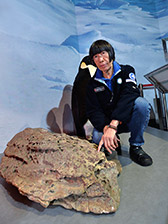
Music maker:
China’s Polar Research Institute has lent a chunk of gneiss from the South Pole known as the wind chime stone for display. Polar winds blowing through the holes in its surface produce sounds.
Music maker:
China’s Polar Research Institute has lent a chunk of gneiss from the South Pole known as the wind chime stone for display. Polar winds blowing through the holes in its surface produce sounds.
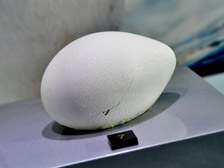
Curiosity generator:
This precious, attention-getting emperor penguin egg may arouse children’s interest in polar animals and their environment.
Curiosity generator:
This precious, attention-getting emperor penguin egg may arouse children’s interest in polar animals and their environment.
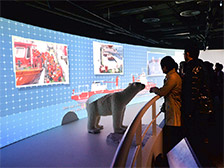
Virtual voyage:
A 13-meter curved screen shows a video of the Xue Long ice-breaking research vessel making its way from Shanghai to the Arctic Ocean.
Virtual voyage:
A 13-meter curved screen shows a video of the Xue Long ice-breaking research vessel making its way from Shanghai to the Arctic Ocean.
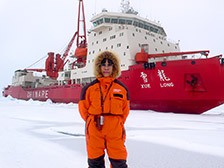
Artistic adventurer:
Designer-turned-explorer Rebecca Lee is the first Hong Konger to have visited the earth’s three extremes - the North and South Poles and the Mount Everest region. (Courtesy of Rebecca Lee)
Artistic adventurer:
Designer-turned-explorer Rebecca Lee is the first Hong Konger to have visited the earth’s three extremes - the North and South Poles and the Mount Everest region. (Courtesy of Rebecca Lee)
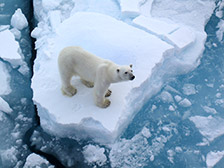
Climate casualty:
Polar bears become global warming victims as their ice-sheet hunting habitat melts away. (Courtesy of Rebecca Lee)
Climate casualty:
Polar bears become global warming victims as their ice-sheet hunting habitat melts away. (Courtesy of Rebecca Lee)
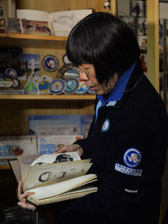
Hand-drawn history:
Her original sketchbooks remind Rebecca Lee of the adventurous expeditions she has undertaken.
Hand-drawn history:
Her original sketchbooks remind Rebecca Lee of the adventurous expeditions she has undertaken.
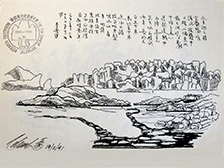
Attention to detail:
Rebecca Lee’s designer background shines through in her intricate sketches of scenes from her journeys, such as these icebergs at the South Pole.
Attention to detail:
Rebecca Lee’s designer background shines through in her intricate sketches of scenes from her journeys, such as these icebergs at the South Pole.
Explorer wants youths to walk in her footsteps
March 23, 2014
The first Hong Konger to explore the earth’s three extremes - the North and South Poles and the Mount Everest region - Rebecca Lee recognises climate change’s impacts and the urgent need to protect our environment.
After trekking to the far corners of the world for almost three decades, Ms Lee had amassed an impressive collection of specimens, photos and sketches that document her excursions. She was keen to put them on public display, to share her findings with others and broadcast the conservation message.
The Chinese University of Hong Kong provided the solution, opening the interactive Museum of Climate Change last December. Its Polar Gallery is replete with multimedia exhibitions centred on Ms Lee’s valuable artifacts.
A model of the Xue Long, or ‘Snow Dragon’, China’s first and only ice-breaking research vessel, greets visitors at the museum entrance. Having been to the poles 18 times, Ms Lee wanted the museum to resemble a research vessel that would take visitors on a virtual visit to the polar regions to understand researchers’ work. A 13-meter curved screen shows a video of the Xue Long making its way from Shanghai to the Arctic Ocean.
Educational curio
The gallery features gear and equipment used on the expeditions, and rocks and other specimens collected from the poles. One item attracts more attention than others: an emperor penguin egg a biologist gave to Ms Lee on a trip to the South Pole in 1991.
“Researchers are forbidden to take any material from the poles without the government’s permission, so I was thrilled,” she said.
The egg travelled with her from the pole to Hong Kong, where it has been on display in her home, office, classroom, and even the Tai Mo Shan Country Park Visitor Centre. It has now found an appropriate permanent home, where she hopes it will arouse children’s interest and imagination.
“When they see the egg, they may search for information about emperor penguins and get to know more about polar animals’ living environment. To be a researcher, you have to be curious about every aspect, from the rocks to the animals, from the seawater to the climate. They are all related.”
Rock music
Asked to name her favourite display, Ms Lee moves to the South Pole wind chime stone. This large chunk of gneiss, a metamorphic rock commonly found at the pole, produces sound when the polar winds blow through the many holes on its surface.
“I had wanted such a rock for more than a decade. I asked China’s Polar Research Institute to give me one once the museum was set up,” she said.
Ms Lee’s maiden expedition to Antarctica took place in 1985. Though she had established a career as a designer, she quickly changed paths, joining the Chinese scientific research team and devoting herself to exploring the extremes.
In the remote Antarctic research stations, Ms Lee lived in a shipping-container cottage. A replica is on display at the museum, furnished with original items she donated.
Ardent artist
She set a copy of a fax that she sent from the South Pole in 1991 on the table. The translated message reads: “While Hong Kong is experiencing hot summer weather, I am staying in the frozen land with dancing snowflakes at the Great Wall station.”
She also retrieved several of her original sketchbooks, with finely detailed portraits of her research teammates, icebergs, polar animals and equipment needed for field trips. As a designer, Ms Lee aimed to showcase science through art.
“There was no digital camera at that time, so I had to use film frugally. I drew whenever I could. I was really good at that.”
One sketch depicts Ms Lee and her seven teammates fighting against the winter storm inside a tent, accompanied by a poem they wrote. She admits she seldom reviews her sketchbooks as she is so busy giving lectures at the university, and captioning tens of thousands of photographs from her 25 years of travel.
Influencing youths
At the age of 71, she feels time is running out.
“I dedicate all my time to education now. When I get older, I may forget the adventures that I had and will not be able to pass them on. Maybe in the future, you will have to remind me that I drew all these sketches myself.”
Ms Lee hopes her experiences may influence the younger generation, to raise their interest in science and environmental protection, or even to walk in her footsteps and become her successor.
“I have high expectations. I hope they understand that our world is much bigger than Hong Kong, and widen their view. Hong Kong teenagers have great potential. They can be geologists, explorers, glaciologists or meteorologists.”
The nascent museum does not yet meet her high expectations, but is still a work in progress, she says.
“I will continue to contact the scientists in China, to see whether there are better exhibits for the museum. I will do as much as I can.”